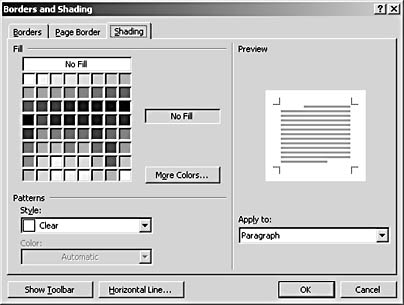Shading Sections
3 4
Sometimes you need more than a border—you need something to help the text, headline, or image really stand out as different from the rest of the publication. For those times, you might want to consider adding a shade to provide color, contrast, or interest to your document.
Applying Shades to Tables and Paragraphs
Word includes a number of predesigned table formats that include many different shading possibilities. You can use one of the preset shades by selecting the table and choosing Table, Table AutoFormat. You can then click each of the format choices to see the shading that's been used in the AutoFormats.
When you want to apply your own shade to a paragraph, table, or headline, follow these steps:
- Select the item to which you want to add a shade.
- Choose Format, Borders And Shading. The Borders And Shading dialog box appears.
- Click the Shading tab. You see the various options you'll use for adding and modifying shades. (See Figure 24-9.)
Note
The borders and shading features of Word work independently, which means that if you add shading without adding a border, the item will appear with only the shade behind it—no outer border will be added automatically. To add a border to the shade, select it and choose Format, Borders And Shading; then choose your border choices on the Borders tab, and click OK.

Figure 24-9. Adding shading can be as simple as choosing the color you want.
In the Fill section, click the color you want to apply. If you don't see the color you want, you can click More Colors to open the Colors dialog box and choose from another selection. Alternatively, you can click the Custom tab in the Colors dialog box to enter the values for your own custom color.
In the Patterns section, click the Style down arrow to display your choices for the density of the color you select. Choose a lower percentage for a lighter shade. The Preview section shows the effect of your choices. Click OK to make your changes. The shade is added to the selected item in your document.
Shading Considerations
Similar to the caveat given earlier about art borders, remember that a little shading goes a long way. Done thoughtfully and with the reader in mind, shades can be very effective in calling attention to certain elements and helping special design objects to stand out on the page. But overusing shading or using the wrong mix of colors and patterns can make your document or Web page harder for people to read, which means they'll turn the page or click through your site—and you'll lose your audience.
To use shading effectively, stay close to these guidelines:
- Use shades on a need-to-use basis. Don't sprinkle shades all the way through your document at random. Give a shade a reason, such as, "Every time we mention a new board member we'll provide a brief biography in a shaded sidebar."
- Choose intensities carefully. A shade that looks light on-screen might show up to be much darker in print.
- Test your contrasts. When you add a colored shade behind text, be sure to increase the contrast between the color of the shade and the color of text. If you choose a dark blue background, black text won't show up clearly. If you choose a dark background, select a light-colored (white or yellow) text.
- Do test prints on a printer of comparable output. If you're printing colored shades, be sure to print a test page on a color printer.
- If you're creating a Web page, use Web-safe colors for your shades. Most Web browsers today can support the standard colors used in the Windows palette. If you choose customized colors, however, other browsers might not display the color accurately. Test the display of the page with different browsers to check the colors you've selected.
Troubleshooting
The Border Changes I Made in My Table Disappeared
If you change the border or shading of a table and find out, when you close the Borders And Shading dialog box, that the changes you selected weren't made, try this fix: Click the Show All button on the Standard toolbar to display all the formatting characters in your document. Now reselect the table, making sure to include the end-of-cell marks at the ends of rows. Next, choose Format, Border And Shading to display the Borders And Shading dialog box, and re-enter your changes. Because the table formatting marks were included, the changes should stick this time.
EAN: 2147483647
Pages: 337